Fracture Parameters and Cracking Propagation of Cold Recycled Mixture Considering Material Heterogeneity Based on Extended Finite Element Method
Abstract
1. Introduction
- (1)
- Obtain the fracture parameters such as peak load, fracture energy, and crack angle using the Arcan test method to study the cracking resistance of CRM;
- (2)
- Verify the mixed-cracking simulation result of CRM with the fracture parameters from the laboratory Arcan test;
- (3)
- Analyze the cracking process of CRM according to the stress distribution at different times in the virtual test;
- (4)
- Investigate the anti-cracking mechanism of CRM with the effect of different notch length on mixed-cracking resistance of CRM studied by FEM.
2. Materials and Methods
2.1. Materials and Specimen Forming
2.2. Arcan Configuration
2.3. Numerical Simulation Method
2.3.1. Homogenization Method of Composite Materials
2.3.2. Model Building
3. Results and Discussion
3.1. Mixed-Mode Cracking Test Results
3.2. Verification of Numerical Simulation Results
3.3. Analysis of Numerical Test Results
4. Conclusions
- The fracture parameters such as peak load, crack angle, and fracture energy were obtained by Arcan tests. The order of displacement fracture energy is Gf-CMOD > Gf-LLD > Gf-CTOD. According to the result of Gf-CTOD, the order of crack resistance of the CR-20 mixture under five kinds of mixed-cracking modes is as follows: Mode A > Mode E > Mode B > Mode D > Mode C.
- The virtual Arcan configuration and two-dimensional digital specimen were set up in the ABAQUS software by using FEM. Considering the material heterogeneity and combined with the XFEM cracking mechanism, the cracking behavior of the CR-20 mixture under different mixed-mode levels was studied.
- According to the reliability of the virtual test, Mode A, Mode B, and Mode D cracking has better simulation in five kinds of mixed-mode virtual cracking tests. Furthermore, the relative error of the Mode D cracking mode is the smallest among the three kinds of mixed-cracking modes.
- With the increase of the proportion of Mode II cracking, the development path of cracks gradually deviates, and the number of failure elements increases. In any mode of cracking process, the stress concentration exists at the crack tip. The cracking propagation of the CR-20 mixture is not only affected by the length of the initial notch but also related to the distribution characteristics of its meso-structure.
- There is a certain relationship between the initial notch length and the initial crack angle, peak load, and fracture energy. Through two kinds of fracture energy, the anti-cracking performance of the CR-20 mixture with different notch lengths under different mixed-cracking modes was evaluated. The results show that the CR-20 mixture with a 10 mm initial notch length has better cracking resistance under the pure tensile stress mode.
Author Contributions
Funding
Institutional Review Board Statement
Informed Consent Statement
Data Availability Statement
Acknowledgments
Conflicts of Interest
References
- AASHTO-AGC-ARTBA Joint Committee. Task Force 38-Report on Cold Recycling of Asphalt Pavements; Ameican Association of State Highway and Transportation Officials: Washington, DC, USA, 1988. [Google Scholar]
- Gu, F.; Ma, W.; West, R.C.; Taylor, A.J.; Zhang, Y. Structural performance and sustainability assessment of cold central-plant and in-place recycled asphalt pavements: A case study. J. Clean. Prod. 2019, 208, 1513–1523. [Google Scholar] [CrossRef]
- Ma, T.; Ding, X.; Zhang, D.; Huang, X.; Chen, J. Experimental study of recycled asphalt concrete modified by high-modulus agent. Constr. Build. Mater. 2016, 128, 128–135. [Google Scholar] [CrossRef]
- Jiang, J.; Li, Y.; Zhang, Y.; Bahia, H.U. Distribution of mortar film thickness and its relationship to mixture cracking resistance. Int. J. Pavement Eng. 2020, 1–10. [Google Scholar] [CrossRef]
- Sreedhar, S.; Coleri, E.; Haddadi, S.S. Selection of a performance test to assess the cracking resistance of asphalt concrete materials. Constr. Build. Mater. 2018, 179, 285–293. [Google Scholar] [CrossRef]
- Mandal, T.; Ling, C.; Chaturabong, P.; Bahia, H. Evaluation of analysis methods of the semi-circular bend (SCB) test results for measuring cracking resistance of asphalt mixtures. Int. J. Pavement Res. Technol. 2019, 12, 456–463. [Google Scholar] [CrossRef]
- Jiang, J.; Dong, Q.; Ni, F.; Zhao, Y. Effects of loading rate and temperature on cracking resistance characteristics of asphalt mixtures using nonnotched semicircular bending tests. J. Test. Eval. 2018, 47, 2649–2663. [Google Scholar] [CrossRef]
- Gao, L.; Ni, F.; Braham, A.; Luo, H. Mixed-mode cracking behavior of cold recycled mixes with emulsion using Arcan configuration. Constr. Build. Mater. 2014, 55, 415–422. [Google Scholar] [CrossRef]
- Gao, L.; Li, H.; Xie, J.; Yang, X. Mixed-mode fracture modeling of cold recycled mixture using discrete element method. Constr. Build. Mater. 2017, 151, 625–635. [Google Scholar] [CrossRef]
- Zhao, Y.; Ni, F.; Zhou, L.; Gao, L. Three-dimensional fracture simulation of cold in-place recycling mixture using cohesive zone model. Constr. Build. Mater. 2016, 120, 19–28. [Google Scholar] [CrossRef]
- Fries, T.; Belytschko, T. The extended/generalized finite element method: An overview of the method and its applications. Int. J. Numer. Meth. Eng. 2010, 84, 253–304. [Google Scholar] [CrossRef]
- Zhao, Y.; Jiang, J.; Zhou, L.; Ni, F. Improving the calculation accuracy of FEM for asphalt mixtures in simulation of SCB test considering the mesostructure characteristics. Int. J. Pavement Eng. 2020, 1–15. [Google Scholar] [CrossRef]
- Pietras, D.; Sadowski, T. A numerical model for description of mechanical behaviour of a Functionally Graded Autoclaved Aerated Concrete created on the basis of experimental results for homogenous Autoclaved Aerated Concretes with different porosities. Constr. Build. Mater. 2019, 204, 839–848. [Google Scholar]
- Chen, K.; Qiu, H.; Sun, M.; Lam, F. Experimental and numerical study of moisture distribution and shrinkage crack propagation in cross section of timber members. Constr. Build. Mater. 2019, 221, 219–231. [Google Scholar]
- Wang, X.; Li, K.; Zhong, Y.; Xu, Q.; Li, C. XFEM simulation of reflective crack in asphalt pavement structure under cyclic temperature. Constr. Build. Mater. 2018, 189, 1035–1044. [Google Scholar] [CrossRef]
- Wang, X.; Zhong, Y. Reflective crack in semi-rigid base asphalt pavement under temperature-traffic coupled dynamics using XFEM. Constr. Build. Mater. 2019, 214, 280–289. [Google Scholar]
- Department of Transportation in Jiangsu Province. Technical Specification of Cold In-Place Recycling with Emulsions; Department of Transportation in Jiangsu Province: Jiangsu, China, 2010. (In Chinese) [Google Scholar]
- Kima, H.; Hong, S.; Kim, S. On the rule of mixtures for predicting the mechanical properties of composites with homogeneously distributed soft and hard particles. J. Mater. Process. Technol. 2001, 122, 109–113. [Google Scholar]
- Farno, E.; Baudez, J.C.; Eshtiaghi, N. Comparison between classical Kelvin-Voigt and fractional derivative Kelvin-Voigt models in prediction of linear viscoelastic behaviour of waste activated sludge. Sci. Total Environ. 2018, 613–614, 1031–1036. [Google Scholar] [CrossRef]
- Tian, W.; Qi, L.; Su, C.; Liang, J.; Zhou, J. Numerical evaluation on mechanical properties of short-fiber-reinforced metal matrix composites: Two-step mean-field homogenization procedure. Compos. Struct. 2016, 139, 96–103. [Google Scholar] [CrossRef]
- Ye, W.; Li, W.; Shan, Y.; Wu, J.; Ning, H.; Sun, D.; Hu, N.; Fu, S. A mixed-form solution to the macroscopic elastic properties of 2D triaxially braided composites based on a concentric cylinder model and the rule of mixture. Compos. B Eng. 2019, 156, 355–367. [Google Scholar] [CrossRef]
- Ling, C.; Bahia, H. Modeling of aggregates’ contact mechanics to study roles of binders and aggregates in asphalt mixtures rutting. Road Mater. Pavement Des. 2020, 21, 720–736. [Google Scholar] [CrossRef]
- Paulino, G.H.; Song, S.H.; Buttlar, W.G. Cohesive zone modeling of fracture in asphalt concrete. In Proceedings of the 5th International RILEM Conference-Cracking in Pavements: Mitigation, Risk Assessment, and Preservation, Limoges, France, 26–30 March 2004; pp. 63–70. [Google Scholar]
- Kim, H.; Buttlar, W.G. Discrete fracture modeling of asphalt concrete. Int. J. Solids Struct. 2009, 46, 2593–2604. [Google Scholar] [CrossRef]

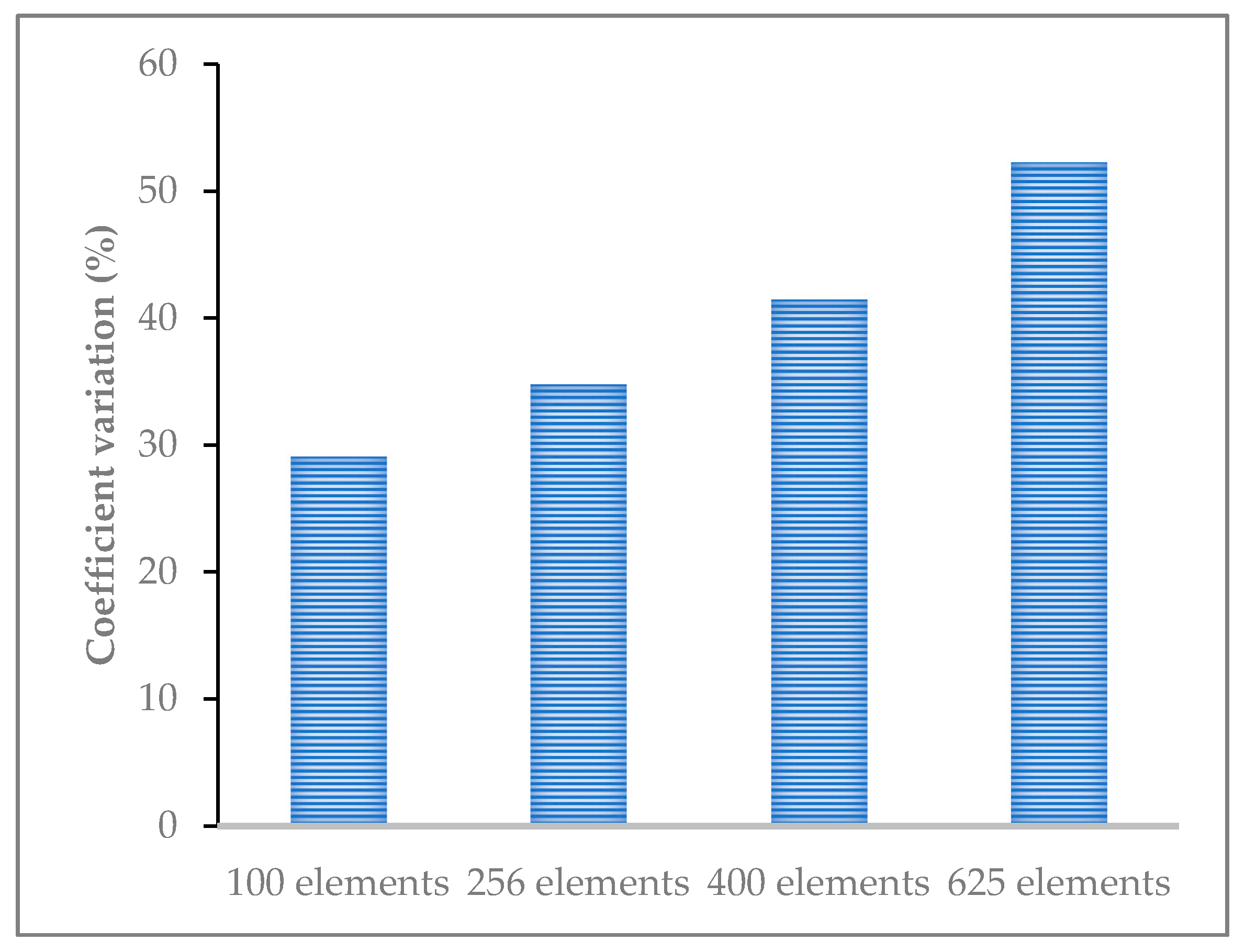


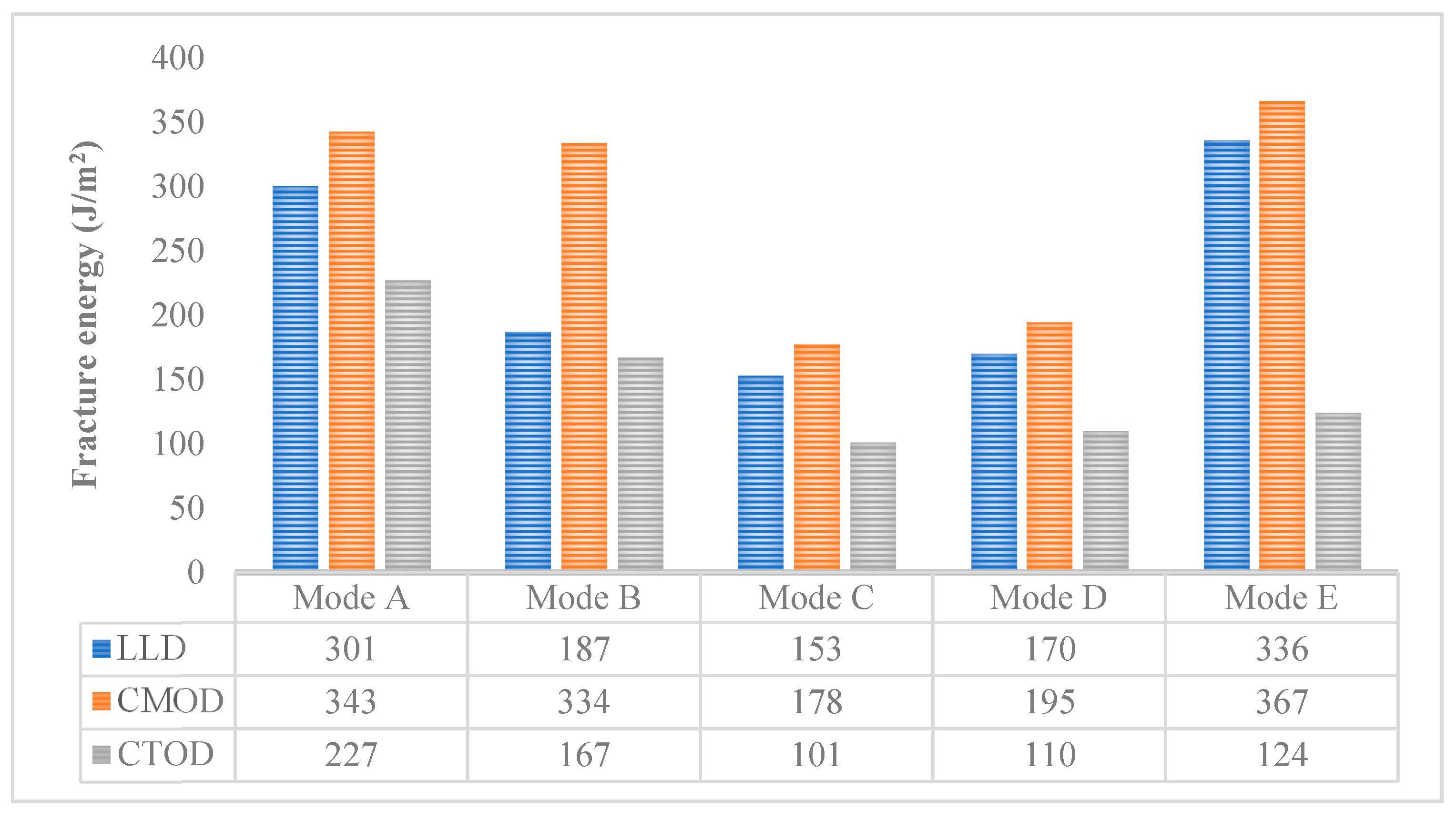


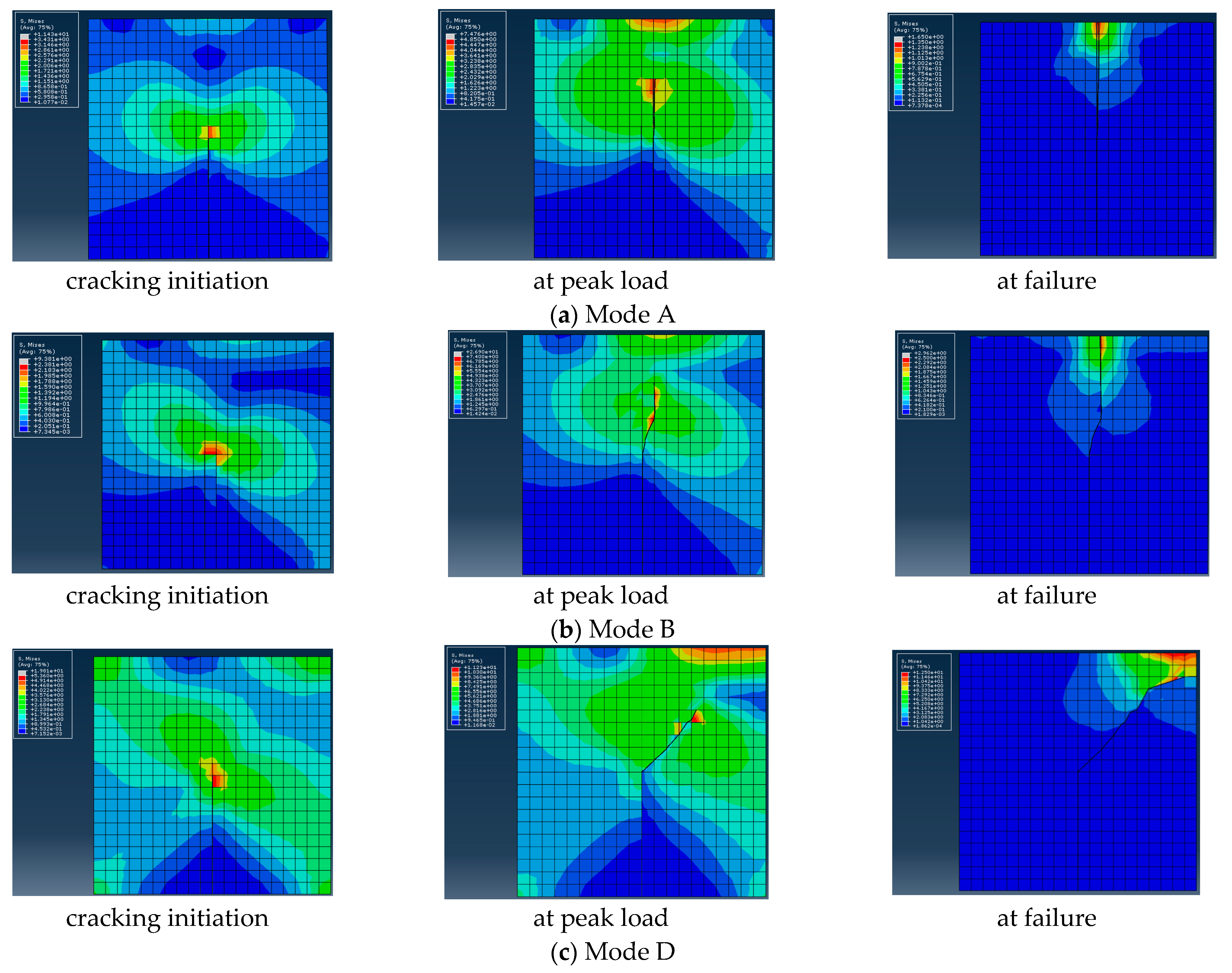
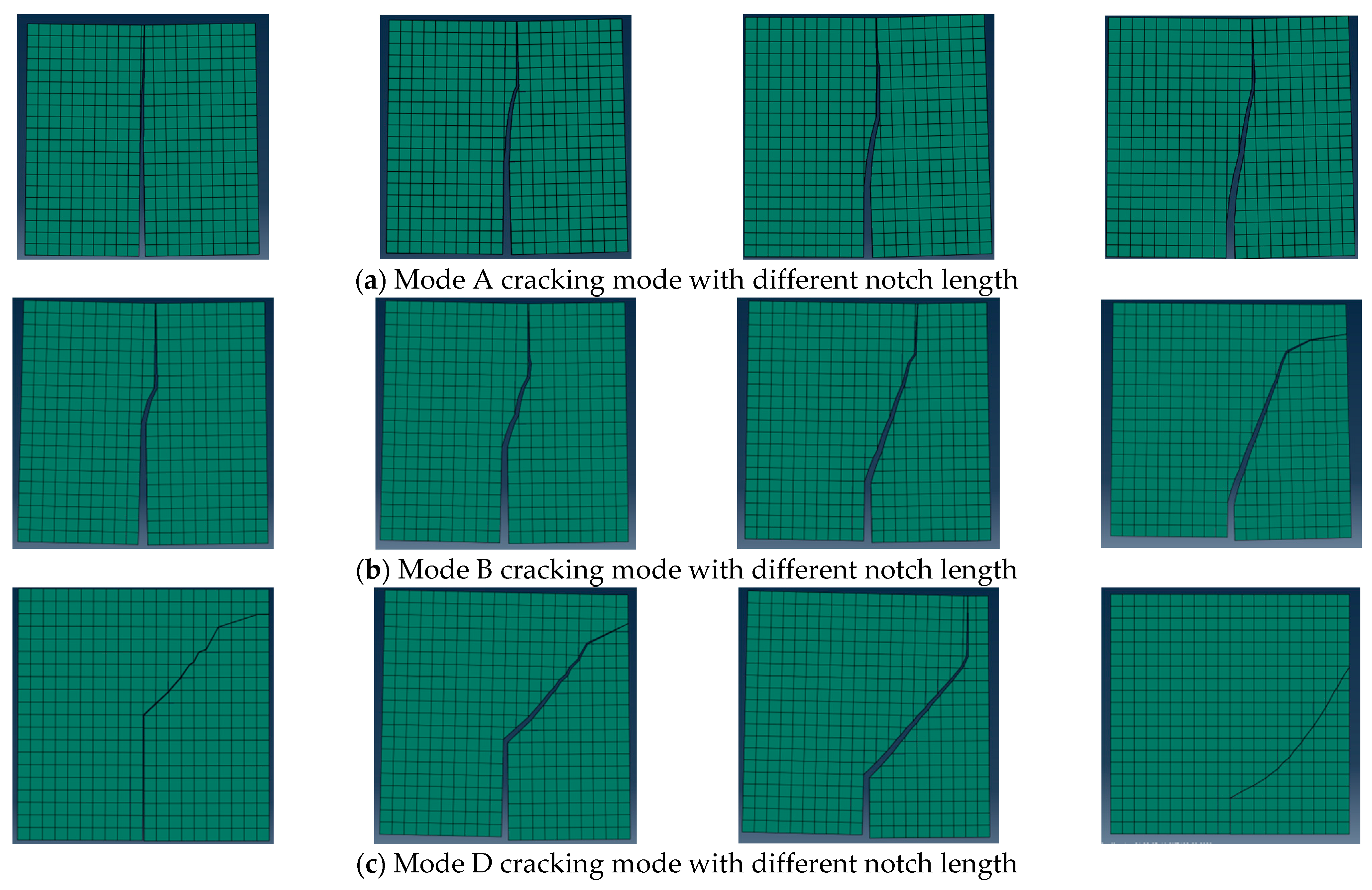
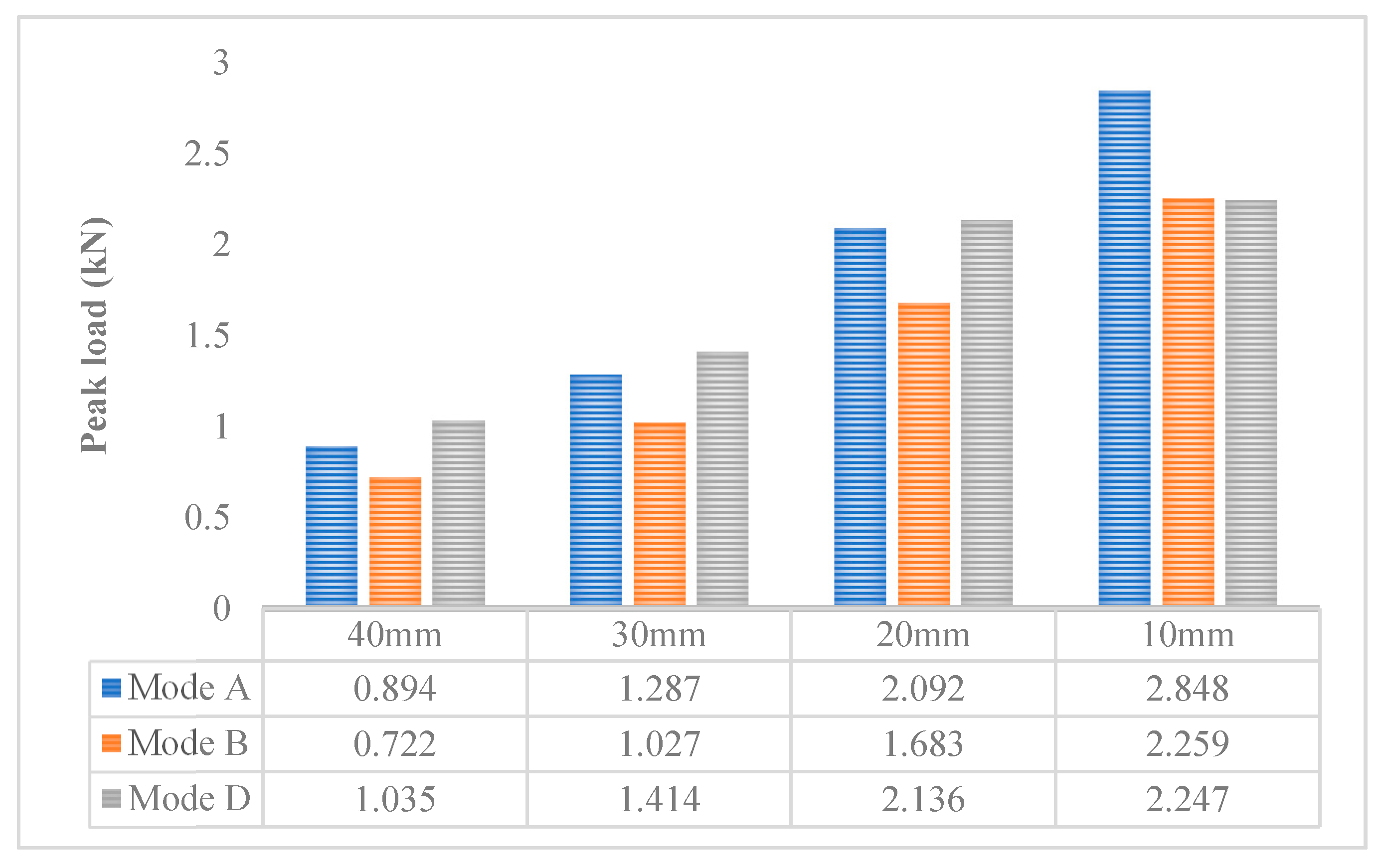
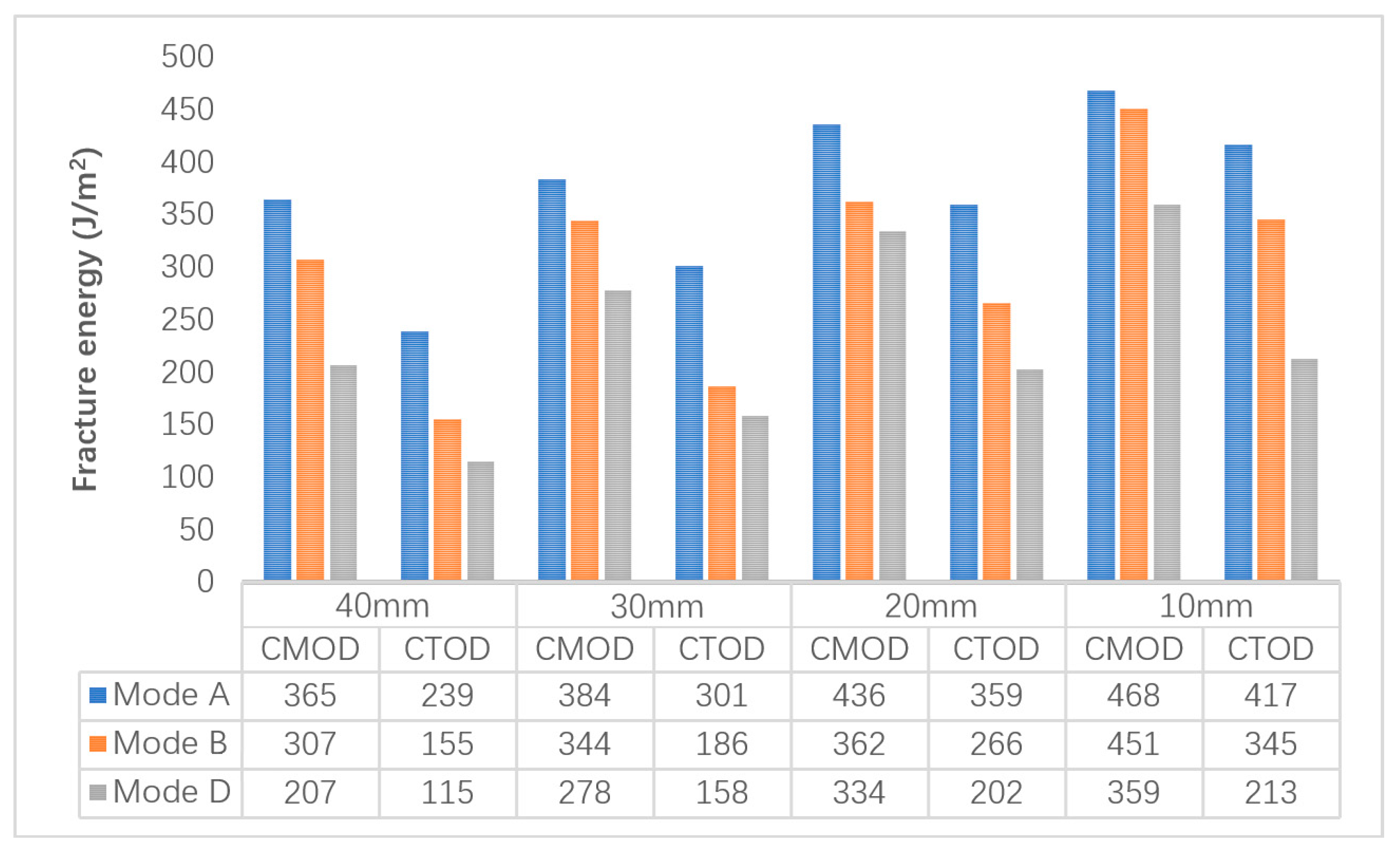
| Mixtures | CR-20 | |
|---|---|---|
| Optimal Asphalt Content (%) | 3.5(CSS-1) | |
| Sieve Size (mm) | Passing Percent (%) | Limits |
| 26.5 | 100 | 100 |
| 19 | 96.7 | 90–100 |
| 16 | 92.4 | - |
| 13.2 | 84.3 | - |
| 9.5 | 70.1 | 60–80 |
| 4.75 | 50 | 35–65 |
| 2.36 | 36 | 20–50 |
| 1.18 | 22.2 | - |
| 0.6 | 14.5 | - |
| 0.3 | 8.3 | 3–21 |
| 0.15 | 6.1 | - |
| 0.075 | 3.7 | 2–8 |
| Fracture Energy | Mixed-Mode Level | |||||
|---|---|---|---|---|---|---|
| Mode A | Mode B | Mode C | Mode D | Mode E | ||
| Gf-CMOD (J/m2) | Simulated Gf-CMOD | 365 | 307 | 127 | 207 | 215 |
| Experimental Gf-CMOD | 343 | 334 | 178 | 195 | 367 | |
| Relative error | 6.41% | 8.08% | 28.65% | 6.15% | 41.42% | |
| Gf-CTOD (J/m2) | Simulated Gf-CTOD | 241 | 155 | 73 | 116 | 67 |
| Experimental Gf-CTOD | 227 | 167 | 101 | 110 | 124 | |
| Relative error | 6.17% | 7.18% | 27.72% | 5.45% | 45.97% | |
Publisher’s Note: MDPI stays neutral with regard to jurisdictional claims in published maps and institutional affiliations. |
© 2021 by the authors. Licensee MDPI, Basel, Switzerland. This article is an open access article distributed under the terms and conditions of the Creative Commons Attribution (CC BY) license (https://creativecommons.org/licenses/by/4.0/).
Share and Cite
Gao, L.; Deng, X.; Zhang, Y.; Ji, X.; Li, Q. Fracture Parameters and Cracking Propagation of Cold Recycled Mixture Considering Material Heterogeneity Based on Extended Finite Element Method. Materials 2021, 14, 1993. https://doi.org/10.3390/ma14081993
Gao L, Deng X, Zhang Y, Ji X, Li Q. Fracture Parameters and Cracking Propagation of Cold Recycled Mixture Considering Material Heterogeneity Based on Extended Finite Element Method. Materials. 2021; 14(8):1993. https://doi.org/10.3390/ma14081993
Chicago/Turabian StyleGao, Lei, Xingkuan Deng, Ye Zhang, Xue Ji, and Qiang Li. 2021. "Fracture Parameters and Cracking Propagation of Cold Recycled Mixture Considering Material Heterogeneity Based on Extended Finite Element Method" Materials 14, no. 8: 1993. https://doi.org/10.3390/ma14081993
APA StyleGao, L., Deng, X., Zhang, Y., Ji, X., & Li, Q. (2021). Fracture Parameters and Cracking Propagation of Cold Recycled Mixture Considering Material Heterogeneity Based on Extended Finite Element Method. Materials, 14(8), 1993. https://doi.org/10.3390/ma14081993





